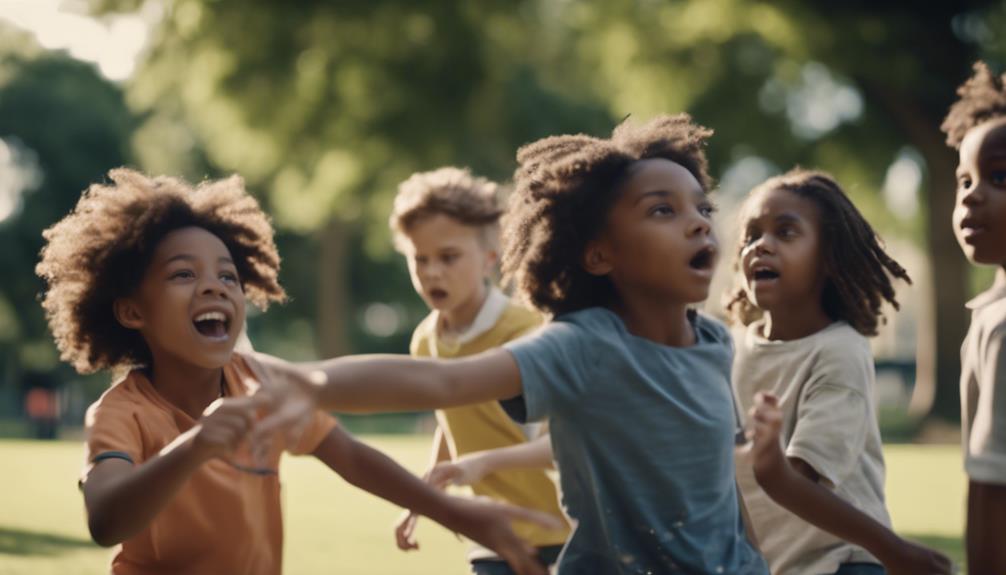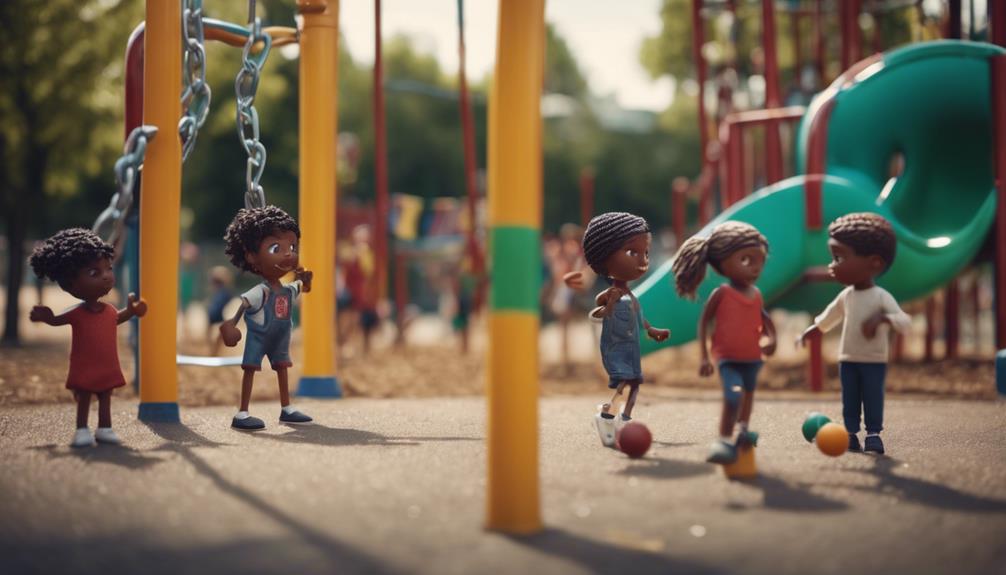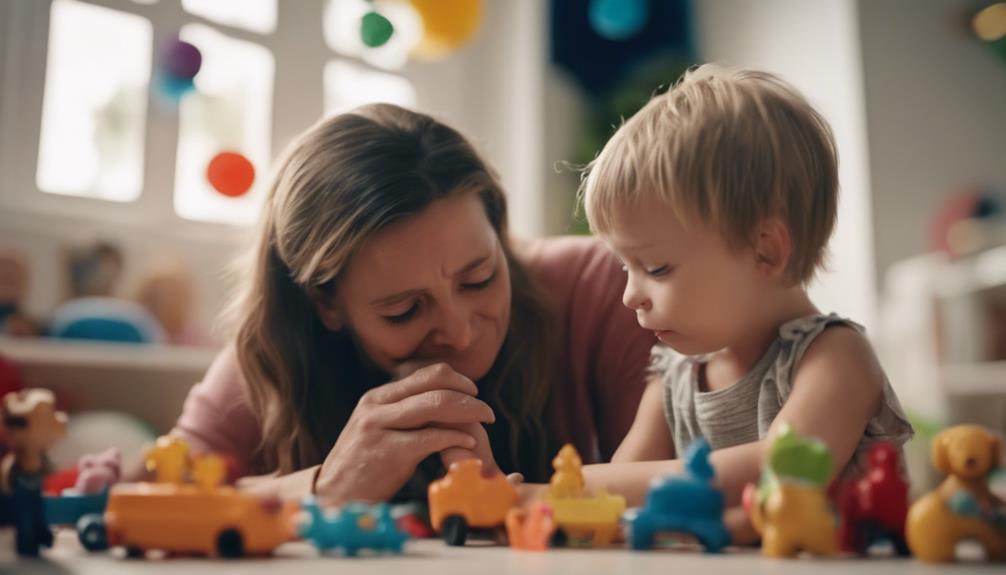Safety Tips
Stranger Danger Baby: Teaching Safety Through Play
Adventure into the world of 'Stranger Danger Baby' as we explore how teaching safety through play can empower children with life-saving skills.

Teaching safety through play is essential for educating children about 'Stranger Danger' and empowering them with essential skills. Understanding warning signs, role-playing scenarios, and identifying trusted adults are all part of this interactive learning process. By fostering assertiveness, refusal of gifts from strangers, and promoting group play, children build resilience and confidence. Setting boundaries, staying cautious, and seeking help from reliable figures are key aspects of safety education. Building confidence through role-playing and recognizing warning signs are critical for child safety. Invest in your child's safety by incorporating play-based learning to equip them with life-saving skills.
Key Takeaways
- Use interactive role-playing to teach warning signs.
- Foster safety awareness through play-based education.
- Encourage identifying trusted adults for help.
- Teach refusing gifts from strangers and setting boundaries.
- Promote safety in numbers and playing in groups.
Understanding Stranger Danger
To protect yourself from potential risks, understanding stranger danger is essential. Teaching children about the warning signs of suspicious and potentially dangerous individuals is vital in promoting their safety. Children are often advised never to talk to strangers and to seek help from trusted adults if they feel uncomfortable or unsafe.
Educating children about stranger danger involves discussing scenarios where they might encounter unfamiliar individuals and how to react appropriately. By role-playing different situations and highlighting the importance of recognizing safe strangers, kids can better understand how to navigate encounters with unknown individuals.
Empowering children with the knowledge of stranger danger not only helps them stay safe but also instills a sense of awareness and preparedness in potentially risky situations.
Importance of Safety Education

Safety education is essential for children as it equips them with the knowledge and skills to navigate potential dangers effectively.
Through interactive learning activities, kids can engage in real-life scenarios to practice safety rules and responses.
Safety Awareness for Kids
Educating children about the importance of safety awareness plays a pivotal role in reducing their vulnerability to potential dangers. By teaching kids about staying safe, they can recognize warning signs and respond appropriately in risky situations.
Understanding safety empowers children to seek help from trusted adults when needed, promoting a sense of security and protection. Kids who are educated about safety develop confidence in setting boundaries and asserting themselves, especially when dealing with strangers.
This knowledge not only equips children with practical skills but also instills a sense of empowerment that can be vital in safeguarding their well-being. Safety education isn't just about imparting knowledge; it's about arming children with the tools they need to navigate the world securely and confidently.
Interactive Learning Activities
How can interactive learning activities enhance children's understanding of safety education?
Interactive learning activities play an essential role in teaching children about safety, particularly in the context of stranger danger. By engaging in role-playing exercises and hands-on scenarios, children can grasp safety concepts in a practical and memorable way. These activities empower children to develop essential skills to navigate potential dangers confidently.
Through interactive learning, children not only learn safety rules but also internalize them, fostering a deep understanding of how to respond to risky situations. Play-based safety education allows children to actively participate in creating safe environments, instilling a sense of responsibility for their own well-being.
Real-Life Scenarios Practice
Engaging in real-life scenarios practice is essential for children to develop effective responses to potential dangers. Through role-playing, kids can build confidence in handling dangerous situations and learn to recognize warning signs.
By actively participating in safety education exercises, children can understand how to stay safe in various scenarios. Practicing real-life scenarios not only enhances awareness but also empowers children to make informed decisions when faced with unfamiliar situations.
By simulating encounters with strangers and teaching children how to react, they become better equipped to protect themselves in the real world. This hands-on approach allows kids to internalize safety measures, making them more likely to respond appropriately when encountering potential risks.
Emphasizing real-life scenarios in safety education provides practical skills that can help children navigate different environments confidently and securely. By actively engaging in these exercises, children can develop the tools needed to stay safe and handle challenging situations effectively.
Role-Playing for Safety Awareness

Using interactive role-playing activities is a valuable method for enhancing safety awareness in children.
Role-playing allows children to practice responses to dangerous situations, such as being approached by strangers. By simulating real-life scenarios, children learn to react confidently, say no, seek help from trusted adults, and stay safe. This approach helps children understand the importance of being cautious and assertive in unfamiliar situations.
Additionally, role-playing teaches children to recognize warning signs of suspicious behavior and take appropriate actions to protect themselves. Through these simulated experiences, children develop the skills needed to navigate potential risks effectively.
By engaging in role-playing activities, children can internalize safety practices in a practical and engaging manner. This method not only educates children on safety protocols but also empowers them to respond proactively when faced with potentially harmful situations.
Identifying Trusted Adults

Identifying trusted adults is essential in equipping children with a reliable support system for seeking help in uncomfortable or dangerous situations. Talk to your children about the importance of having trusted adults they can turn to when dealing with strangers.
Trusted adults can be parents, grandparents, teachers, coaches, neighbors, or family friends. Encourage your children to identify at least three individuals whom they feel comfortable seeking help from. These trusted adults should be reliable, supportive, and known to the child in various settings to make sure they can provide assistance when needed.
Assertiveness Training for Children
Assertiveness training equips children with the skills to confidently respond to dangerous situations, empowering them to say no to strangers and seek help from trusted adults. Through role-playing exercises, children can practice setting boundaries and learn how to stay safe. This form of teaching safety emphasizes the importance of recognizing and avoiding potential risks from strangers.
By fostering assertiveness in children, parents and educators aim to instill the ability to listen to their instincts and take decisive action in unsafe situations. Encouraging children to assert themselves can help build their self-confidence and resilience when faced with unfamiliar or threatening encounters.
Refusing Gifts From Strangers

Teach children the importance of never accepting gifts from strangers to guarantee their safety. Strangers look out for opportunities to approach children with enticing offers, so it's vital to educate kids on the risks associated with accepting gifts from unknown individuals. Children need to understand that it's important to refuse gifts from strangers to keep themselves safe. Emphasize the signs of suspicious behavior that may accompany offers of gifts, such as strangers who never ask for permission from parents or exhibit overly friendly behavior. By instilling the idea that it's crucial to say no to gifts from unfamiliar individuals, children can learn to protect themselves from potential dangers. Below is a table summarizing key points regarding refusing gifts from strangers:
| Refusing Gifts From Strangers | Importance |
|---|---|
| Teach children to say no to gifts from strangers | Vital for safety |
| Emphasize signs of suspicious behavior | Protects from potential risks |
| Encourage setting boundaries and declining offers | Prioritize safety |
| Reiterate the message that it's okay to refuse gifts | Ensure safety and well-being |
Safety in Numbers

When children play outside or in public places, their safety is enhanced by sticking together with friends or siblings to create safety in numbers. Playing in groups not only fosters a sense of camaraderie but also acts as a deterrent to potential predators.
Encouraging kids to stay with a buddy can provide added support in emergencies and unfamiliar situations. In the scenario of a stranger approaching in a car, being in a group can help children feel more confident and secure.
It's crucial to teach children about the concept of safe strangers and the importance of playing in groups, especially in public places. By emphasizing the value of staying together, parents and guardians can instill a sense of responsibility and awareness in children when it comes to their own safety.
Avoiding Unknown Interactions
To protect yourself from potential risks, being cautious around unfamiliar individuals is essential. Children should know that in dangerous situations, it's okay to say no to adults who make them feel uncomfortable. One way to prepare children for these scenarios is by teaching them about safe strangers like Police officers. Below is a table that highlights key points on how children can navigate unknown interactions effectively:
| Situation | Action |
|---|---|
| A stranger offers you candy | Politely decline and walk away |
| An adult asks you to keep a secret | Remember not to keep secrets from parents or trusted adults |
| You feel unsafe and need help | Look for a police officer or a teacher for assistance |
| A stranger in a car asks for directions | Keep a safe distance and do not approach the vehicle |
| An adult asks you to go somewhere with them | Politely refuse and find a trusted adult for help |
Building Confidence in Children

Exploring unfamiliar interactions adeptly can instill confidence in young children to handle potential risks with assertiveness. Role-playing scenarios, such as those provided by KidSmartz, offer a safe environment for children to practice responding to danger, thereby boosting their self-assurance.
Teaching children to stay put if they ever find themselves lost not only guarantees their safety but also empowers them to navigate dangerous situations with confidence. Encouraging children to make noise when in distress can give them the courage to take action and attract attention for rescue effectively.
By educating children on warning signs of suspicious behavior, they can develop the confidence to recognize and respond to potential dangers proactively.
Incorporating these strategies into safety training for children not only equips them with essential skills but also fosters a sense of confidence in their ability to handle challenging situations. Building confidence through preparedness and practice is key in helping children navigate the complexities of personal safety with resilience and assertiveness.
Frequently Asked Questions
How Do You Teach a Child Stranger Safety?
When teaching a child stranger safety, emphasize the importance of recognizing safe adults, saying no assertively, and seeking help. Encourage them to not talk to strangers, refuse gifts, and stay with friends for safety.
How to Help Babies With Stranger Danger?
Help babies with stranger danger by teaching them to recognize familiar faces and voices for security, like a lighthouse guiding ships to safety. Gradually introduce new people in a controlled setting, model appropriate reactions, and provide a safe environment for learning.
What Are Four Rules of Stranger Danger Safety?
Never talk to strangers, don't accept gifts, yell no, and avoid cars. Remember these rules to stay safe. Practice through play helps you learn and stay smart. Role-play and group safety can make a difference.
Why Is It Important to Teach Stranger Danger?
Just like a compass guides you through unknown paths, teaching stranger danger is essential for your safety. Understanding how to respond in risky situations and recognizing safe options empowers you to seek help confidently.
Conclusion
To sum up, teaching children about stranger danger through play is an essential aspect of safety education. By incorporating role-playing scenarios, identifying trusted adults, and emphasizing assertiveness and refusal skills, parents and caregivers can help build confidence in children to navigate potentially dangerous situations.
Remember, safety is a priority and ensuring children are equipped with the knowledge and skills to protect themselves is vital in today's world. Stay vigilant and proactive in teaching safety practices to keep children safe.
Safety Tips
How to Prevent Flat Head in a Baby: Simple Steps
Start preventing flat head in your baby with these simple steps to ensure a healthy head shape and development.
To prevent flat head in your baby, focus on proper head positioning and muscle development. Encourage tummy time to strengthen neck and back muscles, reducing the risk of flat spots. Change head positions during play to promote varied movements. Use a firm mattress to support the head. Limit time in car seats and swings to avoid prolonged pressure. Decrease use of baby gear for active playtime. Check with healthcare professionals for guidance. Following these steps can help guarantee your baby's head develops healthily. Additional information on prevention and care is available for those interested in further details.
Key Takeaways
- Encourage tummy time for strong neck muscles.
- Change head position during playtime.
- Use a firm mattress for proper head support.
- Limit time in car seats and swings.
- Supervise tummy time for healthy development.
Importance of Head Position
Properly positioning your baby's head during sleep is important to prevent flat head syndrome. When babies spend extended periods with their head in the same position, it can lead to flat spots forming on the back or sides of their head. This condition, known as plagiocephaly, can impact healthy head shape development. To avoid this, it's essential to make sure that your baby's head isn't consistently resting against flat surfaces.
By regularly changing the direction your baby's head faces while sleeping, you can help distribute pressure evenly, reducing the risk of developing a flat head.
Additionally, supervised tummy time is crucial for strengthening your baby's neck muscles and preventing flat spots on the head. This activity not only aids in preventing flat head syndrome but also promotes overall development.
Consider incorporating specialized flat head prevention devices under professional guidance to maintain proper head shape while ensuring your baby's comfort and safety.
Encouraging Head Movements

Encouraging your baby to move their head from side to side during playtime is an effective way to prevent flat spots on their head. By actively engaging your baby with toys or using direct gaze to attract their attention, you can promote head movements in both directions.
Regularly stimulating infants to turn their heads towards both sides can help prevent flat head syndrome and promote balanced skull development. During playtime, make sure to promote varied head movements to guarantee the baby's head shape remains well-rounded and symmetrical.
Promoting Tummy Time

To prevent flat head syndrome, engaging in tummy time is essential for your baby's muscle development.
Tummy time not only strengthens neck and back muscles but also promotes healthy head and neck alignment in infants.
Remember to supervise tummy time sessions and aim for at least 30 minutes daily to guarantee maximum benefits for your little one.
Importance of Tummy Time
Engage your baby in daily supervised tummy time sessions to promote healthy muscle development and prevent flat head syndrome. Tummy time is essential for strengthening neck and back muscles, aiding in the prevention of flat spots on the head.
During these supervised sessions, your baby can practice lifting their head, promoting better head movement and contributing to overall muscle development. By encouraging tummy time, you help guarantee healthy head and neck alignment in infants, reducing the risk of developing flat head syndrome.
Engaging Tummy Time
Start by incorporating tummy time into your baby's daily routine to promote healthy muscle development and prevent flat head syndrome. This important practice involves placing your infant on their stomach while supervised for at least 30 minutes each day.
Tummy time aids in strengthening neck and back muscles, vital for preventing flat head syndrome and promoting proper head and neck alignment. To enhance this experience, consider using a maternity pillow like Koala Hugs to support your baby during tummy time exercises.
Engaging in tummy time early on can greatly benefit your baby's overall development. By encouraging this daily activity, you're helping your infant build the necessary strength in their muscles to support their head and neck properly.
Tummy Time Tips
Incorporate tummy time into your baby's daily routine to promote healthy muscle development and prevent flat head syndrome. Tummy time is an important activity that helps strengthen your baby's neck and back muscles, ultimately aiding in the prevention of flat head syndrome.
It's recommended to provide supervised tummy time sessions for about 30 minutes each day to guarantee ideal muscle development. By encouraging your infant to spend awake time on their stomach, you're actively promoting the healthy alignment of their head and neck muscles.
Proper supervision during tummy time is essential to ensure the safety and effectiveness of this activity. Through consistent and supervised tummy time, you're laying the foundation for your baby's overall muscle development.
These simple yet significant steps can have a lasting impact on your baby's health and well-being, ensuring they grow strong and healthy while reducing the risk of flat head syndrome.
Avoiding Prolonged Positions

To prevent flat head syndrome in babies, limit the amount of time they spend lying down to avoid prolonged positions. When your baby is constantly positioned in the same way for extended periods, it can lead to flattening of their head shape. It is important to vary your baby's positions throughout the day to prevent this from happening. Avoid turning your infant on their side or stomach for too long, as this can also contribute to flat head syndrome.
Here is a table outlining some tips to help you avoid prolonged positions and promote varied positions for your baby:
| Tips to Avoid Prolonged Positions | Description |
|---|---|
| Use baby carriers | Carry your baby to reduce time spent lying down. |
| Hold your baby | Holding your baby can also prevent prolonged positions. |
| Change crib position | Alter the crib's orientation to discourage constant head turning. |
| Adjust baby's position in the crib | Change how your baby is placed inside the crib to prevent flat spots. |
Using Prevention Devices

Consider consulting healthcare professionals to guarantee the safe and effective use of flat head prevention devices in preventing flat head syndrome in babies. Specialized devices like Koala Perfect Head pillows are designed to help prevent head misshaping. To maximize benefits, it's important to seek professional recommendation on the appropriate usage of these flat head prevention devices.
These devices work by distributing pressure evenly on your baby's head, aiding in the prevention of flat spots. When using prevention devices, remember to incorporate supervised tummy time to further support healthy head development. Healthcare professionals can guide you on the proper selection and use of these specialized devices, ensuring they're advantageous for your baby.
Consulting Healthcare Professionals

When it comes to preventing flat head syndrome in your baby, consulting healthcare professionals is vital. They can provide expert advice tailored to your baby's specific needs and offer recommendations on safe sleeping positions and devices.
Regular check-ups with a pediatrician or healthcare provider are necessary to make sure your baby's head shape is developing healthily and to address any concerns promptly.
Expert Advice Importance
Seek professional guidance early to receive personalized advice on preventing flat head syndrome in babies. Consulting healthcare professionals is vital as they can assess specific risk factors and recommend tailored prevention strategies. Expert guidance guarantees the use of safe methods to prevent and address flat head syndrome effectively.
Healthcare providers can also suggest specialized devices or techniques that are appropriate for your baby's needs. Early intervention, guided by professionals, is essential in implementing preventive measures successfully. By seeking expert advice, you can gain valuable insights into the best practices for avoiding flat head syndrome in your baby.
Remember that each baby is unique, and what works for one may not work for another. Trusting in the expertise of healthcare professionals can help you navigate the complexities of flat head prevention with confidence and peace of mind.
Regular Check-ups Essential
To guarantee proper monitoring and guidance for your baby's head shape and development, scheduling regular check-ups with healthcare professionals is key.
Here's why these check-ups are essential:
- Expert Evaluation: Pediatricians are trained to monitor your baby's head shape and development accurately.
- Preventive Measures: Healthcare professionals can provide advice on preventive measures to avoid flat head syndrome.
- Early Interventions: Regular check-ups enable early identification of any issues, allowing for prompt interventions.
- Personalized Guidance: Pediatricians can offer personalized advice tailored to your baby's specific needs and concerns.
Frequently Asked Questions
How to Avoid Baby's Head Getting Flat?
To avoid your baby's head getting flat, remember to rotate their head during sleep, engage in supervised tummy time daily, limit time on flat surfaces, use a Koala Perfect Head pillow, and switch the position of the cot and mobiles.
How Can I Keep My Baby's Head Straight?
To keep your baby's head straight, remember to rotate their head while they sleep, encourage tummy time for neck strength, limit time in car seats/swings, use a firm sleeping surface, and seek advice from healthcare professionals about specialized devices if needed.
How Can I Protect My Baby's Head Shape?
To protect your baby's head shape, prioritize firm, flat sleeping surfaces, supervise daily tummy time, and limit prolonged time in car seats or carriers. Remember to rotate their head during sleep and playtime for even development.
How Can I Keep My Baby's Head Round?
To maintain your baby's head round, encourage supervised tummy time, limit time in swings or car seats, use a firm sleeping surface, rotate their head position during sleep, and consider specialized prevention devices recommended by healthcare pros.
Conclusion
In summary, preventing flat head in babies is a straightforward yet important task that can be easily achieved with a few basic steps.
By following the tips outlined in this article, you can guarantee that your baby's head remains healthy and well-shaped.
Remember, a little effort now can prevent a lifetime of discomfort and potential health issues for your little one.
So, take these preventative measures seriously and watch your baby thrive!
Safety Tips
Bye-Bye Baby: Understanding Separation Anxiety
Tackling separation anxiety in infants is crucial for parental guidance and fostering healthy attachments, learn how to navigate this developmental milestone.

Understanding separation anxiety in infants is essential for fostering healthy attachment and guiding through early childhood milestones effectively. It typically emerges around 4-5 months and peaks at 9 months, signifying a vital part of development. Root causes like big changes and unfamiliar environments trigger anxiety. Family strategies involve education, patience, and creating consistent routines. Comfort objects, bedtime rituals, and tailored coping tools aid in managing anxiety. Seek professional help if anxiety persists severely. Consulting specialists for guidance ensures appropriate interventions. Strategically addressing separation anxiety promotes a supportive environment for children's emotional well-being.
Key Takeaways
- Separation anxiety in infants is normal and indicates a healthy attachment.
- Root causes include big life changes, developmental milestones, and unfamiliar situations.
- Family involvement strategies like creating a positive goodbye routine are helpful.
- Practical tips include comfort objects, consistent routines, and tailored coping tools.
- Seek professional help for severe or persistent separation anxiety.
Normalcy of Separation Anxiety
Understanding separation anxiety is an essential aspect of infant development, indicating a healthy attachment between child and caregiver. It's a normal part of growing up, typically emerging around 4-5 months of age and peaking at about 9 months. This phase is pivotal for social and emotional development, representing a healthy aspect of childhood. Signs of separation anxiety can be seen through behaviors like crying when the caregiver leaves, seeking constant closeness, and displaying fear of unfamiliar faces.
Root Causes of Anxiety

Big life changes, developmental milestones, and unfamiliar situations can trigger separation anxiety in children. Understanding the causes and triggers of separation anxiety is crucial for parents and caregivers to address the root issues effectively. It is essential to recognize that factors such as hunger, tiredness, sickness, and boundary-pushing behavior in children can also contribute to separation anxiety, impacting how they handle temporary separations. By identifying the specific causes of separation anxiety, parents can develop strategies to help their children manage and overcome their anxieties. Addressing the root causes not only aids in the management of separation anxiety but also enables parents and caregivers to create a supportive environment that fosters emotional well-being and security in children.
| Causes of Separation Anxiety | Strategies for Parents and Caregivers |
|---|---|
| Big life changes | Establishing routines and predictability |
| Developmental milestones | Encouraging open communication and reassurance |
| Unfamiliar situations | Gradual exposure and desensitization techniques |
| Hunger, tiredness, sickness | Ensuring basic needs are met before separations |
Family Involvement Strategies

To enhance your child's emotional well-being and security, involving the family in strategies to address separation anxiety is essential.
Here are some effective family involvement strategies to help manage separation anxiety:
- Educate family members about separation anxiety to build understanding and support for the child.
- Practice patience and empathy when the child is experiencing separation anxiety to help them feel secure and reassured.
- Create a positive and consistent goodbye routine to make separations easier for the child and family.
- Engage in fun activities or distractions during separations to help ease the child's anxiety and make the process smoother.
Consider exploring family counseling or support to address separation anxiety as a unit and learn additional effective strategies for managing it.
Practical Tips for Managing Anxiety

Introducing comfort objects or loveys can provide reassurance during separations and help manage anxiety effectively. For infants and toddlers experiencing separation anxiety, these items serve as sources of security and reassurance.
Additionally, maintaining a consistent bedtime routine can further enhance feelings of safety and stability. During periods of heightened anxiety, it's important to avoid introducing new habits that may disrupt the established routine. Providing anxiety coping tools and guidance tailored to the needs of young children can aid in managing their emotions and improving sleep quality.
Incorporating a goodbye ritual can also help in easing the change during separations. By implementing these strategies and fostering a supportive environment, parents and caregivers can assist children in navigating through moments of separation anxiety with greater ease and comfort. Remember, patience and understanding play significant roles in helping little ones cope with their emotions effectively.
Seeking Professional Help

Consider reaching out for professional help if your child's separation anxiety is severe or persistent, impacting daily life or causing distress for either of you. Seeking help is vital when the anxiety becomes intense, prolonged, interferes with daily activities, or leads to panic attacks.
It's important to consult a doctor or pediatrician for guidance on managing separation anxiety in children. These professionals can provide valuable insights and recommend appropriate interventions to support both you and your child effectively.
Additionally, seeking assistance from a counselor or psychotherapist can offer additional coping strategies and emotional support. Remember that caregiver anxiety is also a valid concern, and professional support can benefit both the child and the adult in managing their respective anxieties.
Frequently Asked Questions
At What Age Do Babies Get Separation Anxiety?
Babies typically begin to experience separation anxiety around 6-8 months of age when they develop object permanence. It's normal for them to show signs like crying and clinging when their primary caregiver leaves.
At What Age Does Separation Anxiety Typically Peak?
Around 8-10 months, separation anxiety often peaks in infants. Toddlers may face another peak at 14-18 months. Preschoolers can still show signs, understanding parents' feelings by age 3. Hungry, tired, or sick kids find separations tougher. Consistent routines and explanations help.
How Do You Respond to a Baby With Separation Anxiety?
Respond to a baby with separation anxiety by creating a consistent goodbye ritual. Offer comfort and reassurance, practice short separations, stay calm, and avoid rushing goodbyes. This helps the baby feel secure, learn to trust, and understand separations better.
How to Help a Baby With Separation Anxiety Sleep?
To help a baby with separation anxiety sleep, establish a consistent bedtime routine. Use comforting objects for security. Stay calm during bedtime rituals. Avoid sneaking out after they fall asleep. Encourage self-soothing gently. It's important for their security and your peace of mind.
Conclusion
To sum up, understanding and managing separation anxiety in children is a common challenge that many families face.
By acknowledging the normalcy of these feelings, addressing the root causes, and implementing family involvement strategies, parents can help their child navigate through this difficult time.
While seeking professional help may seem intimidating, it's important to remember that it can provide valuable support and guidance in overcoming separation anxiety.
Remember, you aren't alone in this journey.
Safety Tips
How to Ensure Baby Secure Attachment: Key Practices
Build a strong and secure attachment with your baby by mastering key bonding practices – essential for their emotional development and well-being.
To guarantee a secure attachment with your baby, promptly respond to their cues and engage in bonding activities like daily routines and interactive play. Providing a safe and nurturing environment is essential for fostering a strong emotional connection. These key practices lay the foundation for a secure attachment bond, essential for your baby's emotional and social development. By focusing on these fundamental steps, you create a stable and loving environment that nurtures their emotional security and overall well-being. Mastering these practices is important for building a healthy attachment bond with your little one.
Key Takeaways
- Establish consistent routines for feeding, sleeping, and playtime.
- Respond promptly to baby's cues and needs.
- Engage in positive interactions like cuddling, reading, and play.
- Provide a safe and nurturing environment.
- Build trust through consistent and loving care.
Understanding Secure Attachment
To understand secure attachment, recognize it as the emotional bond between a baby and their primary caregiver. It's vital for the baby's development as it provides a sense of security, trust, and comfort.
Building a secure attachment bond involves responding to the baby's needs promptly and consistently. This means being attuned to their cues, whether it be hunger, fatigue, or the need for affection. Responding to these needs helps the baby feel understood and cared for, laying the foundation for a strong attachment.
Nonverbal communication plays a significant role in this process, as it allows the caregiver to understand the baby's signals and respond appropriately. By meeting the baby's needs for food, rest, love, and comfort consistently, parents can create a secure attachment bond that forms the basis for healthy emotional and social development in the child.
Understanding these dynamics is key to fostering a nurturing environment for the baby's overall well-being.
Importance of Secure Attachment

Understanding the importance of secure attachment is essential for fostering healthy child development and well-being. Secure attachment plays a pivotal role in shaping a child's emotional security, self-esteem, and self-control.
Research indicates that children with secure attachments tend to exhibit higher levels of happiness, kindness, and success. Moreover, these children often have better relationships with others, both in childhood and later in life. Academically, children who are securely attached typically perform better, while also experiencing improved physical health.
Secure attachment sets the groundwork for fulfilling relationships in adulthood, highlighting its enduring impact on a child's overall well-being. The quality of the initial human bond significantly influences various aspects of a child's development, including academic performance, social skills, emotional well-being, and cognitive growth.
Secure attachment not only enhances memory and learning abilities but also plays a critical role in shaping a child's future success and relationships.
Parenting Tips for Attachment
To promote secure attachment with your baby, focus on bonding activities that foster connection, such as cuddling, playing, and engaging in interactive communication.
Be emotionally responsive to your baby's needs, offering comfort, support, and affection consistently.
Establishing consistent routines and providing a stable environment will help build a strong foundation for a secure attachment bond with your little one.
Bonding Activities
Engage in daily routines such as feeding, bathing, and bedtime to establish a strong bond with your baby. These bonding activities provide opportunities for positive touch, eye contact, and responsive interactions, essential for building trust and security.
Respond promptly to your baby's cries and cues, demonstrating that you hear and understand their needs. Incorporate skin-to-skin contact and cuddling into your daily routine to promote emotional connection and attachment.
Additionally, interactive play, singing, and reading sessions are great ways to strengthen the bond and foster attachment. Through these activities, you create a nurturing environment that helps your baby feel safe, loved, and connected.
Emotional Responsiveness
Incorporate emotional responsiveness into your interactions with your baby by consistently meeting their needs for comfort, love, and security. By responding promptly and sensitively to your baby's cues, you foster trust and build a strong attachment bond.
Research indicates that babies who experience emotional responsiveness tend to develop better social skills and emotional regulation. This practice contributes greatly to your baby's sense of security, which, in turn, plays an important role in promoting healthy brain development.
By establishing a foundation of emotional responsiveness, you help your baby feel safe, loved, and understood, which ultimately leads to a secure attachment. Remember, your consistent and loving responses to your baby's needs form the building blocks for a trusting and secure relationship.
Consistent Routines
Establishing consistent routines cultivates a sense of security and predictability for your baby, fostering a strong attachment between you and your infant. Essential routines, such as regular feeding and sleeping schedules, play a significant role in promoting emotional development.
Babies thrive on consistency, as it reduces anxiety and helps build a strong bond between caregiver and child. By following a routine, your baby can anticipate their needs being met, which in turn fosters trust and emotional stability. These consistent caregiving routines lay the groundwork for secure attachment by creating a foundation of safety and reliability in your baby's life.
Predictable routines not only enhance your baby's sense of security but also support healthy emotional development. By incorporating consistent routines into your daily life with your baby, you're providing them with the stability and reassurance they need to thrive and form a secure attachment with you.
Self-Care for Secure Attachment

Taking care of yourself is essential for fostering a secure attachment with your baby. By prioritizing your physical and mental well-being, you can better meet your baby's needs with patience and consistency.
Ensuring parental emotional availability and maintaining consistent caregiving practices are key components of self-care that contribute to a healthy and secure attachment relationship.
Parental Emotional Availability
Prioritize your emotional well-being as a parent to nurture secure attachment with your baby. Parental emotional availability plays a significant role in fostering secure attachment, which is vital for your baby's healthy development.
Engaging in self-care practices is essential for regulating your emotions and providing consistent, nurturing responses to your baby's needs. By taking care of your mental health, you create a safe and supportive environment that promotes trust, bonding, and overall well-being in the parent-child relationship.
Being emotionally present and responsive to your baby's cues establishes a strong foundation for secure attachment. This emotional availability allows your baby to feel secure, supported, and understood, leading to a deeper connection and positive developmental outcomes.
Consistent Caregiving Practices
To build a secure attachment with your baby, ensuring consistent caregiving practices is vital for both their well-being and your own. Consistency in caregiving, such as responding promptly to your baby's cues and establishing routines for feeding, sleeping, and playtime, fosters trust and security in the attachment bond. These practices help your baby feel secure and nurtured, promoting emotional stability and aiding in the development of a sense of security. Secure attachment is further strengthened through predictable and loving interactions between you and your baby. Additionally, practicing self-care is essential for maintaining a positive and responsive relationship with your baby. By taking care of yourself, you are better equipped to provide the consistent care and attention necessary for a secure attachment to flourish. Check out the table below for a quick reference on how consistent caregiving practices contribute to building a secure attachment:
| Consistent Caregiving Practices | Benefits |
|---|---|
| Responding promptly to cues | Builds trust and security |
| Establishing routines | Promotes emotional stability |
| Practicing self-care | Maintains positive relationship |
Recognizing Baby's Cues

Pay close attention to your baby's facial expressions, body language, and vocalizations as these cues are essential for understanding their needs. Recognizing these cues will enable you to respond promptly and appropriately, fostering a secure attachment with your little one.
Here are three key ways in which babies communicate their needs:
- Crying: This is the primary way infants communicate distress, hunger, discomfort, or fatigue. Understanding the different types of cries can help you address their needs effectively.
- Cooing: Babbling sounds and cooing are ways babies express contentment and happiness. Responding to these sounds positively reinforces their sense of security.
- Eye Contact and Gestures: Babies use eye contact, pointing, and other gestures to engage with caregivers and convey their desires. Acknowledging and responding to these cues strengthens the bond between you and your baby.
Creating Secure Sleep Environment

For a secure sleep environment for your baby, remember to always place them on their back to reduce the risk of SIDS. This position is vital for promoting safe sleep and minimizing the chances of sudden infant death syndrome.
Additionally, make sure that the crib has a firm mattress with a fitted sheet and avoid using loose bedding or soft toys that could pose a suffocation hazard.
Maintaining a comfortable room temperature between 68-72°F is essential for creating a conducive sleeping environment for your baby. Consider incorporating white noise machines or gentle lullabies to help soothe your baby to sleep, fostering a sense of security and comfort.
Developing a consistent bedtime routine can also aid in signaling to your baby that it's time to rest, further enhancing their sleep quality. By adhering to these practices, you can create a secure sleep environment that promotes attachment and overall well-being for your baby.
Communication and Play

In order to foster a strong attachment with your baby, engaging in interactive play that promotes bonding and communication is crucial.
By incorporating dialogues and non-verbal connections, such as eye contact and gentle touch, you can create a nurturing environment for your little one.
Play not only aids in brain development and emotional regulation but also strengthens the parent-child relationship, laying a solid foundation for your baby's future well-being.
Bond Through Play
Engage in interactive play with your baby to foster secure attachment and enhance communication skills. Play isn't just a vital avenue; it serves as an essential avenue for building strong bonds with your little one. Here's how you can strengthen your relationship through play:
- Create a Safe Environment:
Guarantee the play area is free from hazards, allowing your baby to explore and interact without worry. This sets the stage for a secure and nurturing play experience.
- Follow Your Baby's Lead:
Observe your baby's cues and interests during playtime. By joining in on activities they enjoy, you show them that you value their choices and are actively engaged in their world.
- Be Present and Responsive:
Respond to your baby's sounds, gestures, and expressions promptly. This responsiveness fosters a sense of security and trust, laying the foundation for a strong attachment bond between you and your little one.
Engage in Dialogues
Begin conversations with your baby to nurture a strong attachment bond through interactive communication and play. Engaging in dialogues with your infant is vital for fostering responsive communication and promoting emotional connection. Through playful interactions, you not only enhance cognitive development and problem-solving abilities in your baby but also lay the foundation for language skills and emotional regulation. These dialogues help your little one understand the world around them and build trust in their relationship with you. Establishing a pattern of responsive communication and play can boost your baby's confidence, encourage exploration, and strengthen the bond you share. By actively participating in dialogues with your baby, you create a supportive environment that facilitates social interactions, language development, and emotional well-being.
| Benefits of Engaging in Dialogues | How it Helps |
|---|---|
| Promotes emotional connection | Builds trust |
| Enhances cognitive development | Fosters language skills |
| Encourages exploration | Boosts confidence |
| Strengthens bond with caregiver | Develops social interactions |
Non-Verbal Connections
Establishing non-verbal connections through communication and play is essential for fostering a secure attachment with your baby. When engaging with your little one, remember the importance of non-verbal cues such as tone of voice, facial expressions, and gestures.
Here are some key practices to enhance these connections:
- Use a soothing and affectionate tone of voice: Your baby is sensitive to the way you speak. A gentle and loving tone can convey warmth and security, strengthening your bond.
- Express emotions through facial expressions: Smiling, making eye contact, and mirroring your baby's expressions can create a positive and engaging interaction, promoting feelings of trust and connection.
- Utilize non-verbal cues during play: Incorporate gentle touches, cuddling, and interactive games like peek-a-boo to communicate love and attentiveness without words. These actions reassure your baby and reinforce the secure attachment you share.
Embracing Imperfections

How can embracing imperfections as a caregiver enhance your bond with your baby?
Acknowledging your imperfections and learning from them can greatly impact the parent-child relationship. By demonstrating vulnerability and humility, you create an environment where your baby feels safe, loved, and accepted unconditionally. Trust is built through the acknowledgment of mistakes, fostering resilience in both you and your baby.
Embracing imperfections not only allows for genuine interactions but also promotes a growth mindset, imparting valuable lessons in acceptance and forgiveness to your child. This approach creates a foundation for emotional bonding and strengthens the attachment between you and your baby.
It's essential to remember that perfection isn't a requirement for a secure and loving relationship with your child. Embracing imperfections opens up opportunities for growth, connection, and mutual understanding in the intricate dance of parenting.
Involving Fathers in Attachment
Fathers play an essential role in nurturing secure attachment with their children through emotional support and positive interactions. Involving fathers in the attachment process can greatly impact a child's development:
- Enhanced Cognitive Development:
Research indicates that children with involved fathers demonstrate better cognitive skills, problem-solving abilities, and academic performance.
- Improved Social Skills:
When fathers engage in bonding activities like playing and reading with their children, it fosters stronger social connections, empathy, and communication skills.
- Better Emotional Regulation:
Paternal involvement in caregiving tasks helps children regulate their emotions, cope with stress, and build resilience for handling challenges in life.
Overcoming Attachment Challenges

When facing attachment challenges, it's important to address underlying factors that may hinder the emotional connection between parents and their babies. Parents who've an insecure attachment history may find it challenging to form a securely attached bond with their child, as past experiences can impact their ability to create a strong emotional connection.
Emotional problems such as depression and anxiety can also interfere with the attachment process, making it essential to seek appropriate support. Additionally, issues like drug or alcohol problems in parents can further complicate the establishment of a secure attachment with their babies.
High levels of stress from various sources can also play a role in hindering the development of a healthy attachment bond. To overcome these challenges, seeking additional resources such as therapy options can provide valuable support for parents struggling to create a secure attachment with their babies, aligning with the principles of attachment theory.
Frequently Asked Questions
How to Ensure Baby Has Secure Attachment?
To guarantee your baby has secure attachment, respond consistently to their cues, establish a primary caregiver, show affection through smiling and cuddling, engage in interactive play, and find a balance between meeting their needs and taking care of yourself.
What Are the 4 Key Points on the Importance of Secure Attachment?
You need to understand the 4 key points on the importance of secure attachment. It promotes trust, empathy, brain development, and social skills. Kids with secure attachments are happier, kinder, and better equipped for life's challenges.
What Are 3 Ways You Can Promote Secure Attachments in a Infant or Toddler Room?
To promote secure attachments in an infant or toddler room, you should be consistent with routines, respond promptly to cues, and engage in positive interactions. Creating a safe, loving environment and tailoring care to individual needs are key.
What Are the 4 Pillars of Secure Attachment?
To guarantee secure attachment, remember the four pillars: consistency, responsiveness, understanding your child's needs, and positive interactions. By being consistent, responsive, attentive, and loving, you can build a strong bond with your baby.
Conclusion
In summary, ensuring secure attachment with your baby is vital for their emotional development and well-being.
By following key practices such as understanding your baby's cues, communicating effectively, and involving fathers in caregiving, you can strengthen the bond between you and your child.
Remember, even in challenging times, providing a safe and loving environment for your baby is the foundation for a healthy attachment relationship that will benefit them for years to come.
-

 Activities and Learning4 months ago
Activities and Learning4 months agoEngage Quiet Students With Interactive Quiz Apps
-

 Vetted4 months ago
Vetted4 months ago9 Best Personalized Father's Day Gifts for Your Husband – Thoughtful and Unique Ideas
-

 Activities and Learning4 months ago
Activities and Learning4 months agoAvelox: A Prescription-Free Risk
-

 Activities and Learning4 months ago
Activities and Learning4 months agoActive Forum Requires User Interaction for Access
-

 General Tips4 months ago
General Tips4 months agoStruggling Mom Quotes: Words of Hope and Encouragement!
-

 Activities and Learning4 months ago
Activities and Learning4 months agoRobaxin: CVS Orders, Renal Health Caution
-

 Activities and Learning4 months ago
Activities and Learning4 months agoGet Levaquin: Treat Infections & Stay Safe
-

 Activities and Learning4 months ago
Activities and Learning4 months agoCabaser: Risks, Alternatives, and Gambling Concerns




































